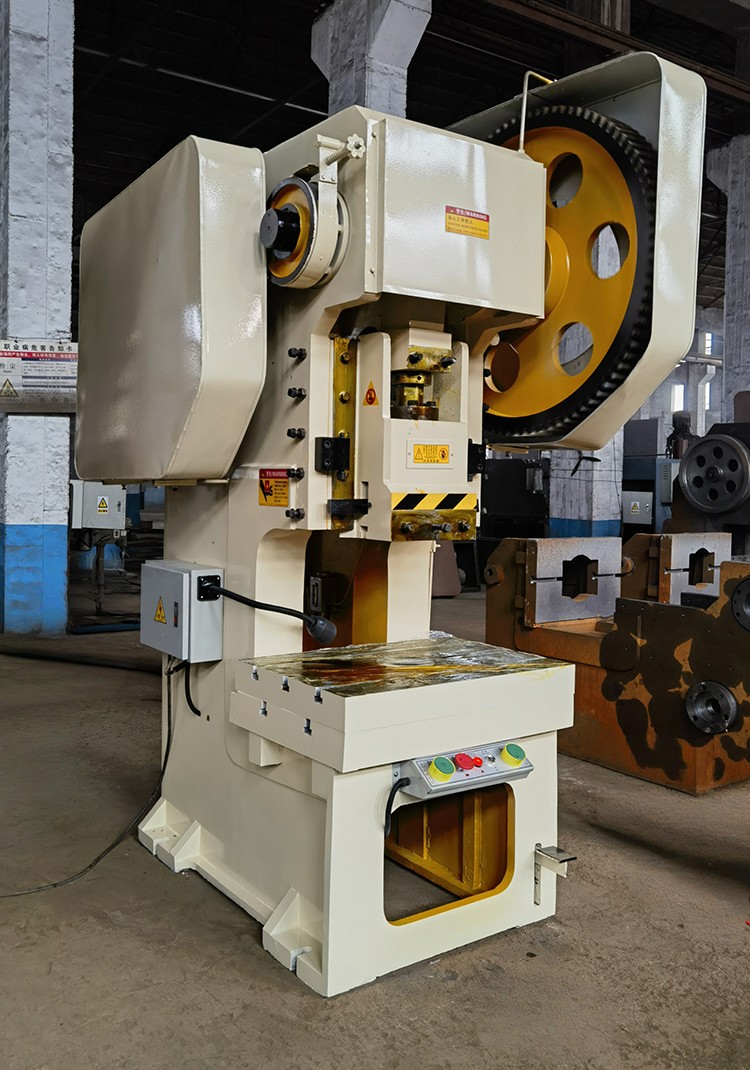

We are a professional mechanical punching machine manufacturer with over 10 years of industry experience. Today, we would like to introduce the classification of mechanical punching machine to you:

Mechanical punching machine is a common pressure equipment in metal processing, which is mainly used for blanking, bending, stretching and other forming processes. According to the different structure, function and drive mode, mechanical punching machine can be divided into many types, each type is suitable for different production needs. The following is an explanation from the main categorization point of view.
1, Categorized by Body Structure
The body structure of the mechanical press directly affects its rigidity and scope of application, mainly divided into two types of open punch press and closed punch press.
Open Type Punching Machine
The body of the open type press is in “C” shape structure, the operation space is open on three sides, which is convenient for loading and unloading and mold adjustment, and is suitable for processing of small and medium-sized workpieces. Due to the weak rigidity of the machine body, the open type press is usually used for stamping operations with small tonnage, such as punching and dropping of small parts. Its advantages are low cost and flexible operation, but relatively low precision and stability.
Closed Type Punching Machine
The body of the Closed Type Punch Press adopts a frame structure with strong overall rigidity, which can withstand large punching pressure and is suitable for high-precision or large-tonnage processing needs. The table of the closed type press is located inside the machine body, and the force is uniform, which is suitable for continuous stamping or processing of large-sized workpieces, such as the molding of automobile cover parts. The disadvantage is that it covers a larger area and the mold adjustment is not as convenient as that of the open type press.
2, Categorized According to The Driving Method
The power transmission method of the mechanical press determines its operation characteristics, which is mainly divided into crankshaft press, eccentric press and friction press.
Crankshaft Punching Machine
Crankshaft presses are the most common type, in which the crankshaft is driven by an electric motor to rotate, and then the slider reciprocates up and down through a connecting rod. Its stroke is fixed, which is suitable for regular stamping operations, such as mass production of standardized parts. Crankshaft presses run smoothly, but the stroke length is not adjustable and less flexible.
Eccentric Punching Machine
Eccentric press adopts eccentric shaft drive, and the stroke of slider can be changed by adjusting the eccentricity, which is suitable for the occasions that need to adjust the stamping depth, such as stretching or bending process. Its advantage is that the stroke is adjustable and adaptable, but the structure is more complicated than the crankshaft press and the maintenance cost is higher.
Friction Punching machine
Friction punching machine utilizes friction disk to transmit power, and manually or mechanically controls the stroke and speed of the slider. This kind of press has simple structure and low cost, but the accuracy and efficiency are poor, mostly used in small batch production or maintenance occasions, and has been gradually replaced by more advanced models.
3, Classified According to Functional Use
According to the different processing technology, mechanical punching machine can be divided into ordinary punching machine and special punching machine.
Ordinary Punching Machine
Ordinary punching machine has versatility, can complete a variety of stamping processes, such as punching, shearing, shallow drawing and so on. Its molds can be replaced, which is suitable for the production mode of multiple varieties and small batch. Common punch press is the most basic equipment in the factory, but its efficiency is not as high as the special punch press.
Specialized Punching Machine
Specialized presses are designed for specific processes, such as fine blanking machines, high-speed presses or multi-station presses. Fine blanking machines are used for high-precision punching and can directly produce parts without burrs; high-speed presses can complete hundreds of punches per minute, which is suitable for high-volume production; and multi-station presses can realize continuous processing through the conveyor mechanism, which significantly improves efficiency. Specialized punching machines have superior performance, but the scope of application is narrower and the investment cost is higher.
4, According to The Degree of Automation Classification
With the development of industry, the degree of automation of mechanical punching machine has become an important classification standard, mainly divided into manual, semi-automatic and automatic punching machine.
Manual Punching Machine
Manual punch press relies on manual feeding and picking up, simple structure, applicable to single piece production or trial production stage. Due to low efficiency and poor safety, they are less frequently used in modern factories.
4, According to The Degree of Automation Classification
With the development of industry, the degree of automation of mechanical punching machine has become an important classification standard, mainly divided into manual, semi-automatic and automatic punching machine.
Manual Punching Machine
Manual punching machine relies on manual feeding and picking up, simple structure, applicable to single piece production or trial production stage. Due to low efficiency and poor safety, they are less frequently used in modern factories.
The classification of mechanical punching machine reflects their diverse application scenarios. Choosing the right punching machine requires comprehensive consideration of processing needs, production scale and cost factors. Understanding the characteristics of different types will help to rationally configure the equipment and improve production efficiency and product quality.
If you are interested in mechanical punching machine, please contact us.
 Address:Room 1202, Detaitang Building, No. 118 Huaguang Road, Zhangdian District, Zibo, Shandong
Address:Room 1202, Detaitang Building, No. 118 Huaguang Road, Zhangdian District, Zibo, Shandong WhatsApp:+8615653328535
WhatsApp:+8615653328535 Wechat: +8615965331535
Wechat: +8615965331535  E-mail:zs@sdsmachinery.com
E-mail:zs@sdsmachinery.com